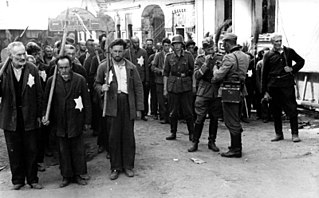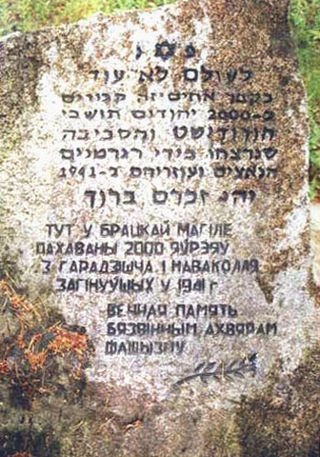
The German invasion of the Soviet Union started on 22 June 1941 and led to a German military occupation of Byelorussia until it was fully liberated in August 1944 as a result of Operation Bagration. The western parts of Byelorussia became part of the Reichskommissariat Ostland in 1941, and in 1943, the German authorities allowed local collaborators to set up a regional government, the Belarusian Central Rada, that lasted until the Soviets reestablished control over the region. Altogether, more than two million people were killed in Belarus during the three years of Nazi occupation, around a quarter of the region's population, or even as high as three million killed or thirty percent of the population, including 500,000 to 550,000 Jews as part of the Holocaust in Belarus. In total, on the territory of modern Belarus, more than 9,200 villages and settlements, and 682,000 buildings were destroyed and burned, with some settlements burned several times. By the end of the war, Belarus had lost half of its population as a result of death and moving.

Haradok or Gorodok is a town in Vitebsk Region, Belarus. It serves as the administrative center of Haradok District. Approximately 14,000 people reside in the town itself and around 30,000 people reside within the district, which is one of the largest in the country. The town is located on the north-east of Belarus and occupies around 3,000 square kilometers. It is situated 30 kilometers away from Vitebsk, the major city of one of the six provinces in the Republic of Belarus. As of 2024, it has a population of 11,533.

The Holocaust in Latvia refers to the crimes against humanity committed by Nazi Germany and collaborators victimizing Jews during the occupation of Latvia. From 1941 to 1944, around 70,000 Jews were murdered, approximately three-quarters of the pre-war total of 93,000. In addition, thousands of German and Austrian Jews were deported to the Riga Ghetto.

Krupki is a town in Minsk Region, Belarus. It serves as the administrative center of Krupki District.

The Brześć Ghetto or the Ghetto in Brest on the Bug, also: Brześć nad Bugiem Ghetto, and Brest-Litovsk Ghetto was a Nazi ghetto created in occupied Western Belarus in December 1941, six months after the German troops had invaded the Soviet Union in June 1941. Less than a year after the creation of the ghetto, around October 15–18, 1942, most of approximately 20,000 Jewish inhabitants of Brest (Brześć) were murdered; over 5,000 were executed locally at the Brest Fortress on the orders of Karl Eberhard Schöngarth; the rest in the secluded forest of the Bronna Góra extermination site, sent there aboard Holocaust trains under the guise of 'resettlement'.

Damachava is an urban-type settlement in Brest District, Brest Region, Belarus. As of 2024, it has a population of 1,142.

The Holocaust in Baranavichy District refers to the systematic persecution and extermination of Jews in Baranavichy District of Brest Region in Belarus by Nazi Germany and its collaborators from 1941 to 1944 during World War II. This was part of the policy of the "Final Solution to the Jewish Question" and an integral part of the Holocaust in Belarus and the broader genocide of European Jewry.

The Holocaust in Brest District refers to the systematic persecution and extermination of Jews in Brest District of Brest Region in Belarus by the occupying authorities of Nazi Germany and collaborators from 1941 to 1944 during World War II. This was part of the broader policy of the "Final Solution to the Jewish Question" an integral aspect of the Holocaust in Belarus and the broader genocide of European Jewry.

Gorodishche Ghetto was a Nazi Jewish ghetto established for the forced relocation of Jews from the village of Gorodishche in the Baranovichi district of the Brest region and nearby settlements. This occurred during the persecution and extermination of Jews under the Nazi occupation of Belarus during World War II.

The Holocaust in the Byaroza District was the systematic persecution and extermination of Jews in the Byaroza District of the Brest Region by Nazi Germany and its collaborators from 1941 to 1944 during World War II. This atrocity was part of the broader "Final Solution to the Jewish Question", which aimed at the complete annihilation of European Jewry and formed an integral part of the Holocaust in Belarus.
Drahichyn Ghetto was a Jewish ghetto in the city of Drogichin in the Brest Region of Belarus. It was operated from July 1941 to October 15, 1942 by the Nazi occupiers of Belarus, and held Jews forced to relocate as part of the Holocaust in Belarus.

Zhabinka Ghetto was a Nazi Jewish ghetto and a place of forced relocation for the Jews of the town of Zhabinka in the Zhabinka district of the Brest region during the persecution and extermination of Jews under the Nazi occupation of Belarus during World War II.

Hantsavichy Ghetto or GantsevichiGhetto was a Nazi Jewish ghetto, a place of forced relocation for the Jews of the city of Gantsevichi (Hantsavichy) in the Brest Region and nearby settlements during the Holocaust in Belarus under the occupation of Belarus by the forces of Nazi Germany during World War II.

Byten Ghetto was a Jewish ghetto and a place of forced resettlement of Jews from the town of Byten in the Ivatsevichy district of the Brest region and nearby settlements during the persecution and extermination of Jews by Nazi Germany during World War II.

Vysokaye Ghetto was a Nazi Jewish ghetto established during the occupation of Belarus by Nazi Germany in World War II. This ghetto served as a place of forced resettlement for Jews from Vysokaye (Vysoko-Litovsk) in the Kamyenyets District of the Brest region, as well as from nearby settlements, during the Nazi persecution and extermination of Jews.

Vowchyn Ghetto was a Nazi Jewish ghetto established during the Nazi occupation of Belarus in World War II. It was a site of forced resettlement for Jews from Vowchyn in the Kamenets district of the Brest region and surrounding areas, during the persecution and extermination of Jews by Nazi Germany.

Kamyenyets Ghetto was a Nazi Jewish ghetto established during the Nazi occupation of Belarus, served as a place of forced resettlement for Jews from Kamyenyets (Kamyenyets-Litovsky) in the Brest region and nearby settlements. This ghetto was part of the broader persecution and extermination of Jews during World War II.

Motal Ghetto or Motol ghetto was a Jewish ghetto established during the Holocaust in the town of Motal, located in the Ivanava Raion of the Brest region, Belarus. This ghetto was a site of forced relocation for Jews from Motol and nearby settlements during the Nazi occupation of Belarus in World War II.

The Horodno Ghetto was established in the summer of 1941 and existed until July 1942. It was a Jewish ghetto located in the village of Gorodnaya, within the Stolin district of the Brest region, Belarus. This ghetto was a place of forced resettlement for Jews from Gorodnaya and nearby settlements during the Nazi occupation of Belarus in World War II.

Khomsk Ghetto was a Jewish ghetto, a place of forced relocation for Jews from the village of Khomsk, Drahichyn District, Brest Region, and nearby settlements during the persecution and extermination of Jews during the occupation of Belarus by Nazi Germany during World War II.


















